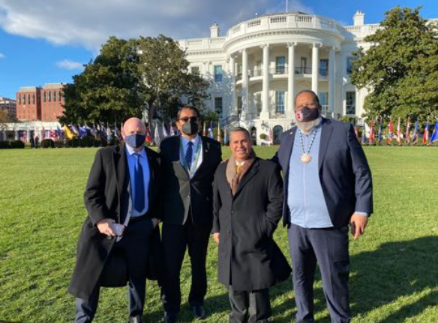Just hours after the beginning of the White House Tribal Nations Summit, President Joe Biden signed the historic $1.2 trillion Infrastructure Investment and Job Act. Among the crowd in the South Lawn of the White House were Navajo Nation President Jonathan Nez and Gila River Indian Community Governor Stephen R. Lewis. They joined members of the president’s cabinet, including Interior Secretary Deb Haaland (Laguna Pueblo), members of Congress, state governors, and local officials from around the United States.

“It was truly an honor to be invited to the White House to represent the Navajo people for this monumental signing of the Infrastructure Bill. This measure will also fully fund the Navajo Utah Water Rights Settlement Act to provide much-needed water resources for Navajo people.” President Nez said.
Want more Native News? Get the free daily newsletter today.
The Investment and Jobs Act will rebuild America’s roads, bridges, and rails; expand access to clean drinking water; ensure every American has access to high-speed internet; tackle the climate crisis; advance environmental justice; and drive the creation of well-paying union jobs.
Major highlights of the Infrastructure Act for Indian Country are:
- Provides the Reclamation Water Settlement Fund with $2.5 billion to fully fund existing Indian Water Rights Settlements.
- Authorizes over $3 billion for the Tribal Transportation Program over five years with an additional $925 million for the Tribal Transportation Facility Bridges program (23 U.S.C. § 202(d)) over five years as supplemental appropriations.
- Authorizes $2 billion for the NTIA Tribal Broadband Connectivity Program and extends the deadlines for use of funds, removes the restriction that funds can only be used during the COVID-19 pandemic, and allows for new and subsequent funding rounds for additional appropriations.
- Provides $3.5 billion over five years for improvements and construction of IHS sanitation facilities under Indian Health Service Sanitation Facilities Construction Program.
- Provides $11.2 billion for grants to States and Tribes for abandoned coal mine land and water reclamation projects. Tribes with programs approved under Section 405 of the Surface Mining Control and Reclamation Act of 1977 are eligible to receive grants.
- Provides $55.426 billion for State and Tribal Assistance Grants for purposes of providing clean and safe drinking water to communities.
- Provides $6 billion for the Battery Material Processing Grant and Battery Manufacturing and Recycling Grant programs that will distribute grants with extra consideration given to eligible entities that partner with Indian tribes.
Not since President Dwight D. Eisenhower signed the Federal Aid Highway Act of 1956 that paid for 90 percent of the nation’s interstate highway system, has there been such a comprehensive piece of legislation to invest in the infrastructure of the United States.
More Stories Like This
Native News Weekly (August 25, 2024): D.C. BriefsUS Presidents in Their Own Words Concerning American Indians
Oral History Project Announces 14th Stop in Portland, Oregon: NABS Continues to Gather Crucial Stories Across Indian Country
Tunica-Biloxi Tribe Acquires GovStrive, Expanding Presence in Federal Workforce Solutions
Small-Dollar Donors Fuel Deb Haaland’s Historic Campaign for New Mexico Governor
Help us tell the stories that could save Native languages and food traditions
At a critical moment for Indian Country, Native News Online is embarking on our most ambitious reporting project yet: "Cultivating Culture," a three-year investigation into two forces shaping Native community survival—food sovereignty and language revitalization.
The devastating impact of COVID-19 accelerated the loss of Native elders and with them, irreplaceable cultural knowledge. Yet across tribal communities, innovative leaders are fighting back, reclaiming traditional food systems and breathing new life into Native languages. These aren't just cultural preservation efforts—they're powerful pathways to community health, healing, and resilience.
Our dedicated reporting team will spend three years documenting these stories through on-the-ground reporting in 18 tribal communities, producing over 200 in-depth stories, 18 podcast episodes, and multimedia content that amplifies Indigenous voices. We'll show policymakers, funders, and allies how cultural restoration directly impacts physical and mental wellness while celebrating successful models of sovereignty and self-determination.
This isn't corporate media parachuting into Indian Country for a quick story. This is sustained, relationship-based journalism by Native reporters who understand these communities. It's "Warrior Journalism"—fearless reporting that serves the 5.5 million readers who depend on us for news that mainstream media often ignores.
We need your help right now. While we've secured partial funding, we're still $450,000 short of our three-year budget. Our immediate goal is $25,000 this month to keep this critical work moving forward—funding reporter salaries, travel to remote communities, photography, and the deep reporting these stories deserve.
Every dollar directly supports Indigenous journalists telling Indigenous stories. Whether it's $5 or $50, your contribution ensures these vital narratives of resilience, innovation, and hope don't disappear into silence.
 The stakes couldn't be higher. Native languages are being lost at an alarming rate. Food insecurity plagues many tribal communities. But solutions are emerging, and these stories need to be told.
The stakes couldn't be higher. Native languages are being lost at an alarming rate. Food insecurity plagues many tribal communities. But solutions are emerging, and these stories need to be told.
Support independent Native journalism. Fund the stories that matter.
Levi Rickert (Potawatomi), Editor & Publisher

